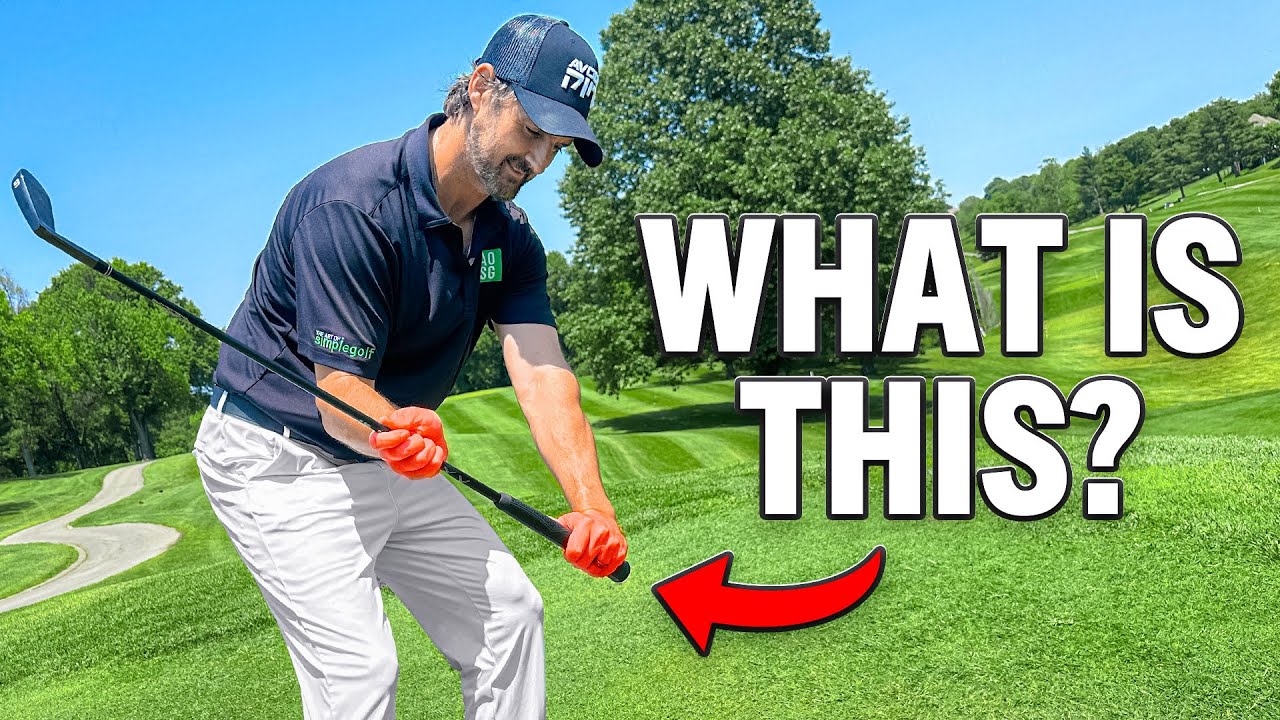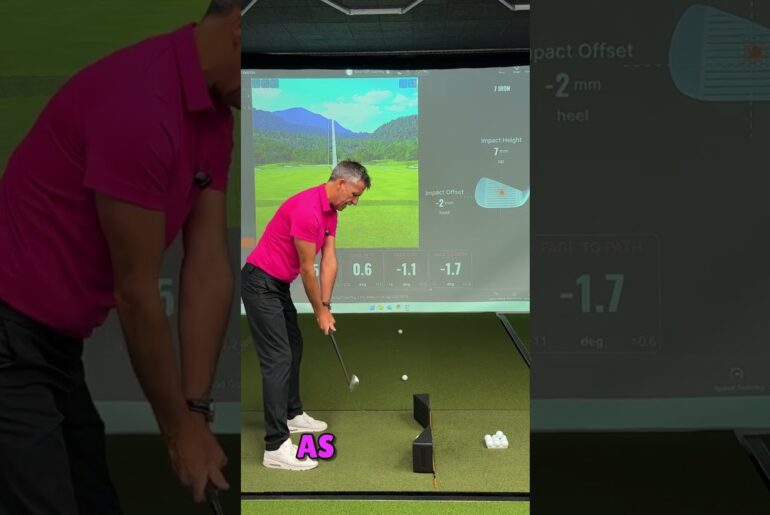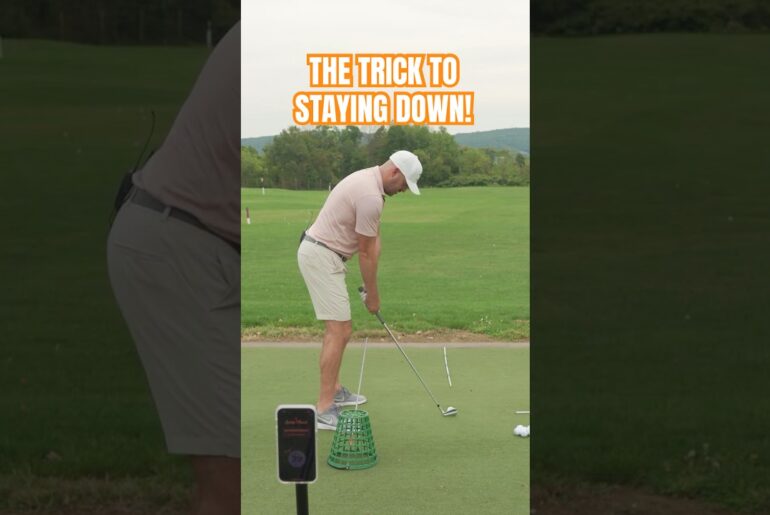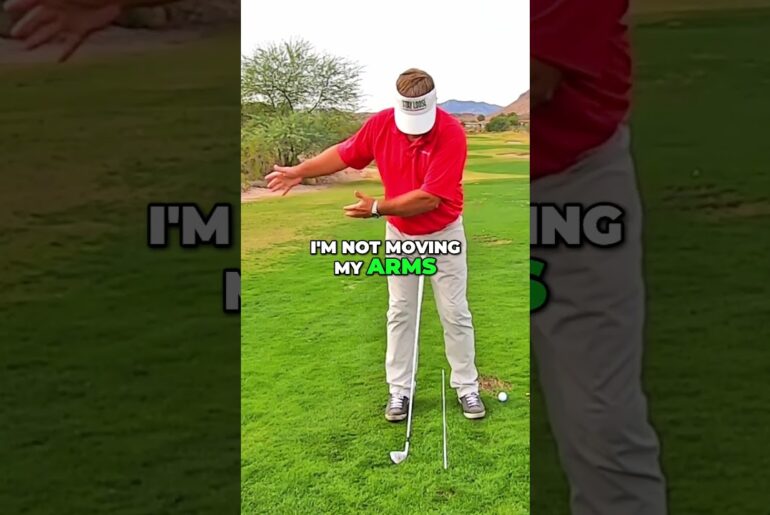Are you so focused on swing positions that you’ve lost your natural ability? Most golf lessons overlook the one key that frees your game. You are a much better golfer than you’re allowing yourself to be, thanks to the non-stop technical noise in your head. When your mind is focused on the wrong things, your body can’t flow.
Today, we change that. I’m giving you the simplest intention to focus on for every shot: the Logo Key.
Stop manipulating the club and start trusting your body again. This single move will instantly improve your consistency and even generate more effortless speed. It’s the simple fix you need to play confident, pain-free golf.
🚨 Next Step: Find Your #1 Simple Golf Fix
👉 Want to know the one simple thing costing you strokes? Take our free, 3-question Simple Golf Quiz for your personalized video lesson. It’s fast, simple, and instantly actionable:
https://quiz.theartofsimplegolf.com/
Need More Simple Golf Lessons?
The Simple Golf System: Learn the complete framework for effortless, body-friendly consistency without the confusion.
The Inner Circle: Join our community for monthly coaching and exclusive lessons.
Watch Next: The Effortless Power Blueprint: [Insert Link to Relevant Video]
#GolfTips #SimpleGolf #GolfLesson #GolfForSeniors #EffortlessPower #TrustYourBody #ConsistencyFREE
premium simple golf swing series ▶ https://theartofsimplegolf.com/
THE ART OF SIMPLE GOLF RECOMMENDED PARTNERS:
AVODA GOLF https://avodagolf.com?sca_ref=6739539.AnFo8rKNTi
JUMBO MAX GRIPS https://jumbomax.com?ref:Theartofsimplegolf
VKTRY INSOLES https://bit.ly/VKTRYsimplegolf
HACKMOTION WRIST https://www.hackmotion.com/artofsimplegolf
Join this channel to get access to perks:
https://www.youtube.com/channel/UCUct4nBOq47nXbHtq7p8eUA/join
——————————————————————————————————–
✅ Watch me next
▶ Don’t Turn Your Shoulders In The Golf Swing – https://youtu.be/Fgs_7A_tVxg
▶ Compress Irons Like a PRO With This Weird Simple Technique (Instant Results) https://youtu.be/xndOYw2nwXU
—————————————————-
▶ FREE SERIES THAT YOU NEED NOW – https://theartofsimplegolf.com/free
▶ VISIT OUR WEBSITE: http://theartofsimplegolf.com
Alex Fortey from the Art of Simple Golf gives you simple tips to improve your golf swing. Enjoy this golf video to help you get closer to having YOUR perfect golf swing.
Let us know what you think in the comments below! 👇
#simplegolf #theartofsimplegolf #Alexfortey
As golfers, we have been exposed to hundreds, maybe even thousands of golf tips that are supposed to help us play better. Trying to make sense of them, let alone apply them is nearly impossible. That’s impossible. Especially when we’re out on the course trying to make it work when we want it to, when it counts. Especially when a lot of them contradict themselves. Whether it’s about get your weight through the ball, make sure you stay centered, hang back on your drives, all these things make it harder and confusing. So, I’m confused. You end up watching videos online and you get to the golf course and you’re actually worse. But what I’m going to do is show you five of the worst culprits that hurt your golf game. Whether you’re a beginner, a seasoned golfer, or just someone looking for that extra edge when you stop doing these five common mistakes, you will play better, and you will have more enjoyment where it matters on the course. Let’s get into it. Believe it or not, this is where many people go wrong with their driver. We’re told to hit longer drives, better drives, we have to tee the ball up higher. on its own, it causes a lot of inconsistencies because it’s in its simplest form, it’s different to an iron. We are now instead of trying to get the ball first and strike down and through getting the turf, we’re suddenly having to sweep the ball off this tee because if we get down too much, we’re going to be getting underneath it, skying it, or whatever. So, what happens is we think, well, to hit it further, I need to lean back a little bit more and I need to try and sweep up. The problem is it’s just too many variables. And drivers nowadays are so well made to make it easier for you to get the ball higher up in the air. We don’t have to really intentionally hit up on the ball. Yes, that can help you to get more distance sometimes. But what yields better results more often than not is hitting the ball out of the middle of the club face. So, I want you to try this. I want you to tee the ball lower. Okay? When I’m teeing it lower, it’s not quite off the floor, but it’s going to really encourage you to just make a more simple, basic, balanced golf swing that can hit it out of the sweet spot, still sweeping, but get that fairway finder that you want. And you will be surprised. It doesn’t kill your distances. It will just help your consistency. Mistake number two. This is common because a lot of times we’re trying to hit the ball too hard, especially with the driver. This is not just exclusively a problem with driver, but it really hurts consistency with every single club in the back. It’s just a bit easier to demonstrate it with the driver. What happens is we’re trying to load up whether it’s a big turn, whether it’s load up the trail side. these buzzwords people hear, but what ends up happening in reality is we move off the ball too much, swaying over here, trying to get behind the ball. So, we have to then try very hard to get back to square, get back to center. This sort of lateral movement, whether it’s with the upper body, whether it’s with the lower body, trying to keep it this way, creates too many variables. Let’s make this simple. If you hit the ball at the middle of the club face more often, you are going to be more consistent. And it’s going to be easier to do that the less movement we have, the less variables we have, the less reliant upon timing that we require. And we do that by very simply, and this is why it’s fantastic on the course because I’m just trying to say stay more centered. I’m feeling my weight distribution in my legs. I’m staying balanced, but as I swing, I’m trying to keep everything feeling pretty much the same. My nose is staying where it is. doesn’t mean I’m not loading up and winding up, but I’m staying centered because from here I can lower the arms and I can swing through. I don’t have to add all this excessive movement. It doesn’t hit the ball any further. It just causes mish hits, bad directions, more frustration. So the next T-shot you have and beyond, really focus on keeping that nose steady, that ball a little bit lower, and just swinging better drives. Now we need to improve our iron shots. Number three, I am here on the fairway. This tip applies to really every single shot, even pitch shots, drives, whatever. And it’s the mistake, the problem of being told to swing slow and easy because what happens when people swing slow and easy? They get too tentative. Now remember, you have to be committed to every single golf shot you hit. Commitment and being confident on each one is the most important thing with every single shot. Even if you’re clubbing up one or two and you do have to swing a bit easier, it doesn’t mean you have to swing hard, but you have to be committed. And the reason why swinging slow and easy is bad is for two main reasons. The first reason why it’s bad is because really, if we’re trying to swing slow and easy, we don’t commit to the shot. We don’t release. We don’t have a specific objective. It’s like we’re just trying not to screw up. But it doesn’t mean that you have to take one less club and hit it hard. It just means that you have to understand that every single shot you hit, you still need to give it a good thump. It still has to be committed, especially through the strike zone. More often than not, when I tell people just to remember that just over the ball like commit, commit to it like you were hitting a a hammer, hitting a nail with a hammer. You wouldn’t go, you wouldn’t be like tapping it in. You’d be thump. And we want that to be the same. The second problem of slow and easy is it creates 99% of the time a swing that is literally just too slow back trying to sort of place it into position and then from the top it’s snatch because you think, well, I can’t I can’t swing like this right now because that’s not committed. So, I need to be committed. I still need to give it some oomph. So, we get to the top and we snatch down and we get sort of messy. The strikes completely go off. It’s not like how we practice. It’s not going to be the most efficient thing. So, what do we do to be more committed? What do we do to get away from that slow that negative kind of swing does not mean swing fast, but what we’re going to try and do is awaken our athlete within us a little bit more. And that is going to be a feeling of actually throwing the club back a little bit more, a bit quicker to start that motion with more intention, more commitment, not just through the strike, but more commitment to just the start of the swing. Let’s not be weak. Let’s not be gentle. Let’s not be scared of what we’re trying to do. Have authority in what you’re trying to accomplish here, even if it’s a small shot. And the way I suggest you do this is by taking a club, at least one more club to what you normally would hit, okay? One or two clubs. And we’re going to work on making sure that we’re doing a sort of shorter, but this type of tempo swing. We’re going to go faster back, slower in transition, and faster through the strike zone. That’s the sort of general flow. It’s going to be whoop there. faster committed. Okay, it’s that sort of sensation that faster and committed. And even when we do that kind of motion, faster committed, it gives us that authority. So don’t try and place the swing back. Don’t think easy does it. I want you to set up with a strong feeling in the legs, confidence and strength in what you’re trying to accomplish. And as we swing back, even with just a half swing, I’m going to go quicker, transition slower to move myself back, and I’m going to make sure I’m committed through that strike zone. So, it’s going to be there. that sort of flow of swing make sure that I get the ball where I want to. If I took the same club there and I know it’s a little bit too much club and I’m trying to swing easy and I try and do an easier, longer, smoother swing, right? What can happen is I just don’t get the strike. I don’t commit to it. Feels all loosey goosey. So commit to your shots. Don’t be scared to have a bit more authority and speed in it. Doesn’t mean you rush it, but you have authority. Now, let’s look at number four. Before we continue the lesson, I want to talk to you about magic mind. These things I’ve been taking for about a month now. Not every single day, but the days when I’ve needed a little bit extra focus, a little bit more energy. And filming is certainly one of those days. But I have noticed these have really helped my energy and my focus. And in such a tiny little shot at the start of the day, it’s been making all the difference. Inside we’ve got neutropics, adaptogens, antioxidants, lion’s mane, the things that give me the focus and energy in just a tiny little shot. It has really made all the difference. And you can learn more about Magic Mind and how it can help you with that link below. And yes, you do get a special discount code. Now, let’s get on with the lesson. Using too much wrist is what’s costing you shots. Why is that? Do we need wrist in the golf swing? Yes. But what happens is people get too focused and narrow on wrist hinge, trying to pick it up this way. We get too narrow. If I said to you, throw this club as far as you can with good intention. You’re not going to really hinge the wrist. You’re just going to throw hold it back. You’re going to throw it back. the club is going to look a bit more like Scotty Sheffller than you are down here. But having that natural feeling to be like, okay, that’s where I throw it from and noticing what my wrists feel like. Yes, some wrists will take action as I start moving back down as long as I’m supple, but I don’t need to really do anything. And I wager you doing a lot less with the wrist trying to intentionally hinge all the time is going to give you more power and consistency. So how do you do that? However you want to in a way I just want you to try and give yourself that task to feel like you are just hinging the wrist a little bit less. Doesn’t mean we’re dead rigid. Doesn’t mean we’re dead rigid and passive. It just means we’re allowing it to to move without trying to. And you will notice that even without trying to hinge those wrists up and down. As long as I can feel the weight of the club and not locked out, I just move the club back. Oh, I have more than enough wrist hinge, especially when I get back down towards the target. But that’s the key. I don’t have to do anything. So, my swing, my main goal as I’m trying to accomplish this is to be a bit stronger in the shapes that I create at setup. And I’m trying to keep those shapes all throughout the swing. I’m not losing it. I’m not trying to collapse. Whatever I start with here, I’m trying to minimize the movement as I go back and as I come through. And what you’ll notice is it gives you just a bit more width and a bit more simplicity. At first it might feel like you’re sort of swinging like this, which isn’t actually that bad, but I know it’s not going to look remotely like that. It’s going to look much more natural like that. You’ll just be surprised at how much less you have to move the wrist to do it. We have full lessons on that, but that’s giving you the first test to just not hinge as much in your golf swing. You have heard never up, never in when it comes to putting. It’s always almost mocked if you leave a putt short. Why is that? It is such an old wives tale, if you want to call it. But we know from data and some very smart people that it is such a fallacy and it hurts your golf game. Before I get into this, I just want to point out this isn’t just me making this up. This is based on data and Scott Forset from Decade has tested and backed this up hundreds of thousands of times. That never up, never in hurts your scores. And you can learn more about Decade Golf below and how it can help you. Just in case you don’t believe me, I want you to test this out. Every putt we hit, let’s say I’ve got a 25 ft putt, okay? I’m not a robot. I’m not going to hit it the same every single time. I’m going to have a dispersion of short, long. Let’s say I hit 10 different putts, but the same length objective. One might sort of go somewhere there, right? It’s a bit downhill, but let’s say my next one, I’m trying to do the same thing, but let’s say my next one goes a little bit further. Okay, goes a little bit further. And you start to realize you have this distance dispersion. After 10 putts, it might be something like here to here. Okay, we always try and reduce this distance dispersion. But let’s say on a 25 foot putt, you you need to allow about, you know, one, two, three feet or so. Okay, that’s the distance dispersion. Why does this matter? Well, if we come up to the hole and I hit 20 putts, it’s kind of difficult on this sloping lie, but I hit 20 putts and my dispersion is going to be somewhere from here to here. Okay, you can see that is pretty optimal because some are going to be, let’s say I was coming from this way, some are going to be short, some are going to be long. Fine, we get that. But what if we always have that mantra of never up, never in. I’m basically making sure that my worst shortest part is going to be level or even a little bit past. Okay, let’s say it was a little bit past. Let’s say there. Now, my dispersion is suddenly going to be let’s say another three feet. 1 2 3. So, we’re here. That’s okay. But that was my short one. My other ones, my average would be somewhere in here. So, I need to expect and allow my short one to not be past the hole because if I’m always left with this or others, that’s not fun. We don’t want to always be holding that kind of distance of putt, do we? So, it applies the other way round. If we use the logic that we want our average to be in the middle of the distance of putt we’re trying to hit, the ones we don’t quite get are going to be about here. The ones we get long are going to be about here. And then hopefully the average is going to be somewhere in the middle whole high lagging those putts. But that can only happen when we understand that putts short to long are fine. They have to be cuz you are going to have more two putts and less three putts. Basically means that I’m not really stressing about getting it to the hole. I’m just trying to get it within my bucket, if you will. I’m really just trying to lag anything from over 25 ft. And my objective is somewhere in here. I’m going to accept because I’m not a machine. Some are going to go long, some are going to go short, but I am not going to really try and hold it because what if I overcook it and my long ones go even further than my short ones? That my short ones are way too long. If I put this into action and I get one a little bit too firm, trying to make sure I hold it, positive putt, whatever. I’ve raced that by that stinks. That’s a really hard putt coming back and it’s even rolling away. What if I just try and lag it? Oh, I’m worried about I’m going to be a little bit short. It doesn’t work out that way because you always get it right within your distance dispersion. Put it to the test. You will be flabbergasted at how much easier this makes longer putting when you take that pressure off of never up, never in. Now, if you want to make sure you hit more greens in the first place and you don’t have as many lag putts required, this lesson is going to help you a lot.








3 Comments
Let me know if you recognize some of these in your own game and 🧠. Thanks for watching and please like and share too! 🏌️💪
I accidentally figured out the tee height fix on my own. Too many pop-ups, pulled shots, shanks, etc. Teed it way lower, and distance isn't impressive but consistency is off the charts (220-230 carry but straight as an arrow almost always). Love these videos!
Idk why but no matter what you say I automatically believe it with your accent